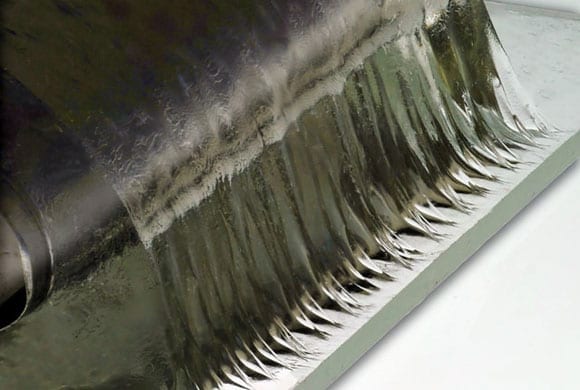
Transparent and viscous, a new synthetic hydrogel from Massachusetts Institute of Technology (MIT) engineers is taking cues from nature.
The new hydrogel’s toughness is comparable to the bond between tendon and cartilage on bone. It can adhere to glass, silicon, ceramics, aluminum and titanium. Additionally, more than 90% of it is composed of water.
“Basically, it’s tough bonding water,” said Hyunwoo Yuk, an MIT graduate student in mechanical engineering.
Natural hydrogels are what allow mussels and barnacles to bond to rocks, ships and whales.
“If you think about it, the human body is a hydrogel soft robot,” said Xuanhe Zhao, an associate professors with MIT’s Dept. of Mechanical Engineering, to Motherboard. “Tissue in the human body contains around 70% water; it’s basically many pieces of hydrogel together with bones, with skeletons, to form a soft robot.”
Attached to two plates of glass, MIT’s hydrogel was capable of supporting a suspended 55-lb weight. Experimenters applied the hydrogel glue to a silicon wafer, which was subsequently smashed with a hammer. Though shattered, the silicon wafer’s pieces were kept intact due to the hydrogel. Used to connect four ceramic bars, the tough hydrogel joints allowed the square to be deformed into various shapes.
In order to create a hydrogel capable of strong bonding, the researchers needed the material to exhibit two characteristics: energy dissipation and chemical anchorage. “A hydrogel that dissipates energy is essentially able to stretch significantly without retaining all the energy used to stretch it,” according to MIT. “A chemically anchored hydrogel adheres to a surface by covalently bonding its polymer network to that surface.”
The latter was achieved through a process called silanation, where the solid substrate is covered with a compound that creates a stronger bond with the hydrogel.
During a peeling test, the bond between the hydrogel and a solid substrate was so strong fibrils clung to the solid material. The researchers found the bond’s strength was 1,000 J per square meter, on par with the bond between tendon and cartilage on bone.
According to MIT, the material can be applied to underwater surfaces, potentially useful as a protective coating for boats and submarines. Additionally, it is biocompatible and may have applications in the medical field.
However, the hydrogels application to robotics and bioelectronics is most intriguing. The material’s flexibility allows for locomotion that mimics natural joints. “It can give a robot many degrees of freedom,” said Zhao.
It’s also conductive. Yuk and colleagues added salts to the hydrogel sample and stuck it between two metal plates connected by electrodes to an LED light. Switched on, the hydrogel enabled ion flow allowing the LED to light.
Read more: MIT Hydrogel is 90% Water
The Latest on: Hydrogel
[google_news title=”” keyword=”Hydrogel” num_posts=”10″ blurb_length=”0″ show_thumb=”left”]
via Google News
The Latest on: Hydrogel
- No Antibiotics Needed – Revolutionary Chronic Wound Treatment Could Help Millionson April 28, 2024 at 1:29 am
An international team of scientists has developed a new treatment for chronic wounds that uses ionized gas to activate a wound dressing, without the need for antibiotics. The treatment involves the pl ...
- NIST researchers develop magnetics-based analyte sensoron April 25, 2024 at 8:45 am
Sensing platform uses magnetized hydrogels and a smartphone’s magnetometer to measure glucose concentration in test samples ...
- Novel Hydrogel Therapy Impedes Invading Pathogenson April 24, 2024 at 3:30 am
To address these gaps, a multi-university team led by New Jersey Institute of Technology’s Vivek Kumar is developing a hydrogel therapy that acts as a first line of defense against viruses and other ...
- Hydrogel Market Beyond Perception Uncharted Territory Techniques Illuminating Observational Researchon April 23, 2024 at 3:47 pm
Report Ocean has unveiled a cutting-edge research report titled “Hydrogel Market” for the year 2024, delving into critical facets such as industry dimensions, market share dynamics, growth ...
- Mechanical engineers develop miniaturized, hydrogel-based electric generators for biomedical deviceson April 22, 2024 at 6:05 am
Mechanoelectrical energy conversion offers a promising solution for powering miniaturized biomedical devices, such as cardiac pacemakers, brain stimulators, wearable drug delivery systems, and more.
- Groundbreaking hydrogel can remove microplastics from wateron April 20, 2024 at 6:01 am
A newly developed hydrogel is going to create new ways for us to remove harmful microplastics from drinking water.
- New Hydrogel Material Removes Microplastics From Wateron April 15, 2024 at 6:16 am
Scientists have developed a new 3D hydrogel material that can adsorb – and degrade – large volumes of microplastic.
- IISc researchers develop hydrogel that can remove microplastics from wateron April 12, 2024 at 9:59 am
Researchers at IISc have developed a sustainable hydrogel to remove microplastics, with a unique polymer network and nanoclusters to degrade contaminants. The hydrogel can efficiently remove up to 95% ...
- IISc researchers design novel hydrogel to remove microplastics from wateron April 12, 2024 at 9:48 am
Researchers at the Indian Institute of Science (IISc) have designed a sustainable hydrogel to remove microplastics from water.
- Novel hydrogel removes microplastics from wateron April 12, 2024 at 6:45 am
Microplastics pose a great threat to human health. These tiny plastic debris can enter our bodies through the water we drink and increase the risk of illnesses. They are also an environmental hazard; ...
via Bing News










